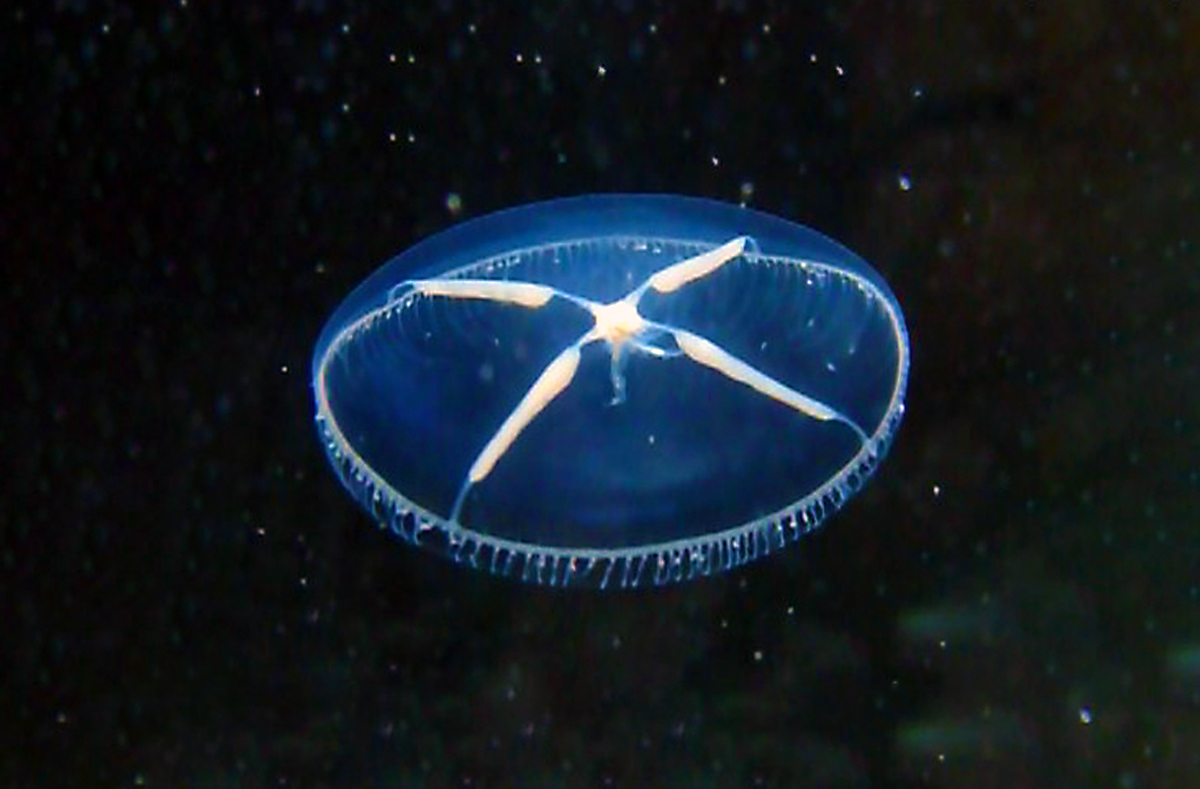Authors: Kelsey Baker and Danielle Boutcher
Scientific name: Mitrocoma cellularia
Size range: to 90mm in diameter.
Authors: Kelsey Baker and Danielle Boutcher
Identifying features: The Cross Jellyfish (Mitrocoma cellularia) may grow to 90mm in diameter. They have up to 340 tentacles that are very thin and flexible and do not contain obvious rings or clusters of cnidocytes. They have a small stomach and from it extends a manubrium with four long frilly lips. They have a transparent bell with four white internal canals that make a distinct “X” shape which they are named after. A narrow bioluminescent band circles the edge of the body from which the hundreds of white tentacles originate and they can glow with a blue-green coloured light. These jelly fish belong to the class Hydrozoa and contain a thin vellum on the inside of their bell that allows them to swim relatively fast.

Habitat: The Cross Jellyfish lives in coastal waters, near the shore of the Pacific Ocean from Alaska to central California. They may be found from 6m to 1600m deep. They prefer low light levels, a temperature range of 2 to15oC, and a salinity of 33ppt.
Food: Cross Jellyfish tend to eat zooplankton and it has been suggested that they may find their food by smell. They capture the plankton in their tentacles around the bell. Smaller individuals have been observed in our classroom aquarium to then fold the bell over to place the food into their mouth. Once the food is in the mouth they take the food into the manubrium and then into the four stomach pouches that radiate outwards – that is why the inside of the jellyfish might turn orange after they eat freshly hatched brine shrimp in captivity. Interestingly they require wild food to be bioluminescent and will not glow in captivity when fed other food types.
Predators: The Cross Jellyfish avoids getting eaten by predators through camouflage since the transparency of the bell makes them a little invisible. They get eaten by other kinds of jellyfish, and are parasitized by larvae of peachia (a sea anemone) and also pelagic amphipods.
The Jellyfish Life Cycle: In general the jellyfish life cycle begins with males and females releasing sperm and eggs into the water. In the water the sperm fertilizes the eggs producing diploid zygotes. The zygotes grow into a ciliated larva. Then the larva swims around looking to attach to a hard surface and then develops into a polyp. The polyp, called a strobila, then reproduces asexually. The strobila looks like a stack of bottle caps and the new jellyfish called ephyra bud off the top of the pile to become free swimming individuals. These then grow into adult medusas.
References
Monterey Bay Aquarium Foundation (1999-2013), 886 Cannery Row, Monterey, California. Retrieved January , 2013 from http://www.montereybayaquarium.org/animals/AnimalDetails.aspx?enc=n3f4wmcSJaPP65dQ7YbJhQ
Wrobel, D., & Mills, C. (1998). Pacific Coast pelagic invertebrates : a guide to the common gelatinous animals. Sea Challengers.
Widmer, Chad L. (2008) How to keep a jellyfish in aquariums: An introductory guide for maintaining healthy jellies. Tucson, Arizona U.S.A: Wheatmark
